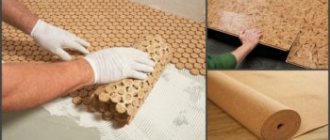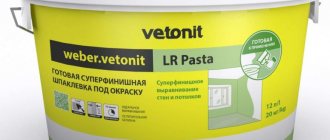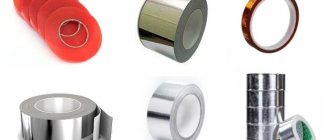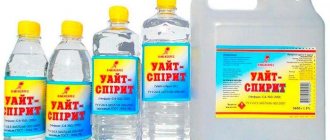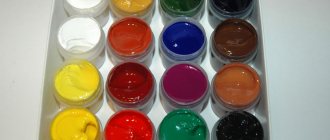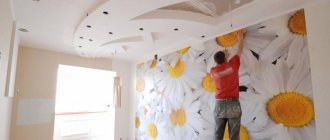Among builders, roofing felt is considered the most reliable roofing material among low-price products. It is made on the basis of durable roofing cardboard, impregnated with petroleum bitumen, and then sprinkled with armor chips. Currently, manufacturers produce several dozen brands of roofing material, which is used for covering utility and industrial buildings, garden and country houses. If you decide to use this material for a roof, you will need roofing felt mastic. In this article we will tell you what this composition is, what types it comes in, and how it is used.
Basic methods of fixing roofing felt
Ruberoid is a complex material from the point of view of its attachment to the roof surface, but its low price and the ability to install it on any roof make it popular. It can also be used as a waterproofing layer when laid on the foundation.
Previously, a method was used in which the bitumen sheet was laid layer by layer and nailed. Practice has shown that this is short-lived, so today this method is practically not used.
Gluing roofing felt using a special mastic greatly simplified the work with the roofing material. This coating is durable, with joints that do not leak. A significant disadvantage is the mandatory heating of the composition for gluing roofing felt. This requires special devices, which is not very convenient, especially when working independently.
Modern bitumen-based compositions are an ideal option that does not require additional preparation. Among the most famous types of glue:
- TechnoNIKOL,
- ABIZOL KL DM TYTAN,
- AquaMast.
Adhesives provide not only reliable fastening of roofing material to the surface, but also good sealing of joints.
Options for laying rolled roofing material
Previously, joint sealing and installation
the material was carried out quite easily: they rolled out a roll of material, which was then nailed through a wooden batten with nails.
A similar installation method turned out to be of poor quality; the coating was not able to last long.
The use of such welding methods, such as the use of molten resin, improved the quality of the work, but turned the procedure into a rather unsafe undertaking.
Fortunately, specialized gluing compounds were developed and began to be produced, which were almost safe to use. Even non-experts and non-experts can use them easily.
TechnoNIKOL glue
TechnoNIKOL is a bitumen-based composition using modern modifying additives, solvents and fillers. It is used for working with roofing felt of all brands, as well as with glass insulation and other rolled materials used in construction for waterproofing. Bitumen mastic glues the roof to concrete, cement-sand and other bases.
Note! Before laying roofing felt on glue, preparatory work is required. The adhesive composition is applied only to a clean coating.
The glue can be used at temperatures from +5 to +35 °C. At a relatively low price (500–600 rubles per 10 liters), the quality of the product meets international standards. The only disadvantage when working with mastic is the high consumption - 1.5–2 kg per 1 sq. m. m.
Installation technology
Ruberoid refers to rolled roofing materials; it is produced on the basis of special cardboard with a density of 200-420 g/m2 and petroleum bitumen. It is used to create a reliable, strong and durable waterproofing coating, each layer of which increases the protective functions of the material. Roofing felt is laid in 3 main ways:
- Mechanical. Laying and securing roofing felt using roofing felt nails is called mechanical. Previously, this technology was popular due to the lack of worthy alternatives. However, it is irrational to fix each layer of material, violating the integrity of the roofing material. This fastening method reduces service life and waterproofing properties.
- Deposition. Laying roofing material using fusing requires the use of special equipment; it cannot be performed on flammable substrates. This technology involves the use of grades of roofing felt, on the underside of which fusible bitumen is applied, which is melted by a gas burner during installation.
- Gluing. Laying roofing felt by gluing is done using a special composition called mastic. Each layer of waterproofing coating is coated with this bitumen substance, and after drying it is securely glued. Currently, this method is considered the most reliable, since it results in a seamless, monolithic roof.
Installation of roofing felt roofing
Scheme for laying roll materials
Note! Using homemade or store-bought bitumen mastic allows you to obtain a reliable waterproofing coating that does not allow moisture to pass through. Each glued layer of roofing material increases the protective properties and service life of the roofing material.
Mastic ABIZOL KL DM TYTAN
A modern adhesive composition with a thick consistency is used for roofing felt of all brands. Main characteristics of mastic:
- temperature range for work – from +5 to +35 °C,
- consumption 0.8–1.5 kg per 1 sq. m,
- drying time minimum 24 hours,
- ability to work on slightly damp surfaces,
- resistance to weak acids and alkaline bases,
- The final set of properties takes 14 days.
The glue is ready for use when cold. It is applied using a roofing brush or paint brush. When laying in several layers, wait until the first layer has dried, and only then continue working.
Video description
In this video, the master clearly shows the process of preparing bitumen primer in two ways:
Application of ready-made glue or mastic
In order to protect builders from burns and poisoning from smoke and fumes of organic solvents, ready-made adhesive compositions were developed.
Application of mastic for bitumen waterproofing Source pol-master.com
They are used in warm, dry weather without heating. Here the basic components are also bitumen resin and organic matter. Before applying the solution, the base must first be treated with the recommended primer. Manufacturers, as a rule, offer their line to obtain the highest quality results.
Here the practical part is simple. The surface is treated with primer. After 2.5-4 hours, the finished mastic or glue is applied in the recommended layer over the entire working area. A sheet of roofing material is laid and pressed manually to the base. The edges overlap by 10-20 cm, the joints are fastened with the same adhesive or double-sided tape.
Bitumen mastic AquaMast
This multi-component mixture is intended specifically for use by individuals and small organizations with little experience in construction work. Unlike the professional line of mastics:
- less technologically advanced
- not intended for industrial volumes with high speed of work performed,
- not suitable for roofs with special operating conditions.
Suitable for most types of hard substrates, including wood. It is considered the best in its price category, thanks to:
- high resistance to temperature changes,
- low consumption of 0.8–1.8 kg per 1 sq. m,
- maintaining uniform texture and properties during freezing,
- wide range of temperature use: from –10 to +40 °C,
- short time for gaining final properties - 7 days.
Important! When using AquaMast mastic at temperatures below +5 degrees, keep the mixture in a warm room for at least 24 hours.
Preparation: organizing the process
Primer: a must
- Station wagon class. It is relevant to use for newly constructed structures.
- Deep penetrating agents. The preparations contain active molecules that, penetrating into the structure of the material, create a filling and binding effect. A widely used example is acrylic-based primers.
- Special silicate-containing. Chemical representatives from the polystyrene series. Due to high toxicity, they are used only for external work and industrial facilities.
Glue: material features
Plastic, drywall and any element can be attached to a concrete surface by gluing, using construction adhesive or other adhesive forms for concrete. The technology industry offers consumers a wide range of products and various appearances. The release form is dry, liquid adhesive for concrete; a new product in the construction industry, emulsion, is widely popular. Positively interacts with rubber, plastic and wood plywood. If you need to glue the material in an environment that often comes into contact with moisture and is subject to temperature changes, it is better to give preference to modifying agents.
Gluing on TechnoNIKOL: brief instructions
Modern and high-tech tools do not require certain preparatory work. Just follow the instructions:
- Prepare the surface for applying mastic: clean it from dust, dirt and other construction impurities. If there is old material (such as tar) on the roof, remove it completely. Dry the surface.
- Fix uneven areas and cracks with concrete mortar.
- Apply a special primer that will make the surface smoother, which will ensure a tight fit.
- Apply glue using a notched trowel, carefully covering the joints with other elements.
- Apply a strip of roofing felt and roll it with a roller from the middle to the edges. If air bubbles have formed, pierce them and distribute the canvas over the surface.
- Place the next sheet with an overlap of 10 cm.
- Additionally, lubricate the joints of the panels.
- Let the first coat dry for 12 hours. Then apply the second and third (if necessary) according to the same pattern.
Important! Do not use mastic in enclosed spaces. When working with the composition, wear suitable clothing and gloves.
Routine repair of roofs made from roll materials ↑
Emergency is an urgent restoration of the roof to maintain functionality. The new coating is laid in places of real leaks and areas where the likelihood of their formation is highest. About 5–20% of the entire roof area is subject to it. If approximately 10–40% of the area is partially replaced, then we can already talk about ongoing repairs. It is performed twice during the year - in spring and autumn.
Making mastic for roofing felt with your own hands
There are two options for preparing the adhesive base for roofing felt, available for independent implementation: cold and hot. Both methods are not inferior to each other in terms of technical characteristics. The compositions are prepared according to the following scheme:
- Cold mastic is made from bitumen and solvent in a ratio of 3:7, respectively. Use gasoline, diesel fuel or kerosene as a solvent. Pre-melt the bitumen, then cool to 85 degrees, add the second component and mix thoroughly. This mixture remains liquid at 20 degrees, which is why it is called “cold”.
- Hot mastic - based on bitumen and filler in the form of limestone, chalk, peat chips, talc, alabaster. Place 8 kg of bitumen in a large container and gradually heat it. Add 1.5 kg of filler, previously sifted from debris. Pour in 0.5 kg of used oil. At the same time, the temperature in the container must be maintained at a constant temperature of 200 degrees. Such bitumen will slightly “hiss” and emit gray smoke, which indicates that the mastic has been prepared correctly.
Important! The process of laying hot mastic requires constant heating of the composition, so during work use a container with thick walls - a standard bucket will quickly burn out.
Both options for making mastic are suitable in cases where it is necessary to patch up a small area of the roof. The consumption of a self-prepared composition is high compared to a professional one. In addition, homemade mastic is not stored in case of incomplete use.
Fastening roofing felt using modern adhesives has simplified the work of builders and installers, as well as individuals. The products are ready for use and do not require special skills. When working with bitumen mastic, follow the instructions for use, as well as the temperature conditions specified by the manufacturer. Properly selected adhesive will increase the service life of the roof.
Preparatory work
First of all, it is necessary to make calculations , both of the roofing material itself and of additional materials that may be required during work.
To cover the roof you will need:
- roofing felt
- bitumen mastic
- blowtorch for heating.
Instead of roofing felt, you can use modern material rubemast or euroroofing felt , which does not require the use of mastic to cover the roof.
Calculating the material is very simple, since each roll indicates the area that can be covered, usually 10-15 m2. calculate the area of a garage roof using the standard formula by multiplying the length of two non-opposite sides of the roof . To the resulting figure you need to add another 20-25%, which will be spent on overlapping the strips and bending the material along the edges of the building.
Before you start covering the garage roof with roofing felt, you must thoroughly clean the surface of the old waterproofing layer , if it has been applied. It is necessary to repair all cracks and irregularities on the plane, for which you can use any suitable solution of cement, plaster, etc.
It is necessary to eliminate all cracks and distortions with an area of more than 5-10 cm. Otherwise, air bubbles or voids may form in their place, which will lead to damage to the coating.
If possible, all dust is blown off the roof; ideally, the concrete surface can be washed with water and allowed to dry thoroughly. This option is only suitable for dry sunny weather.
Maintenance of the finished roof
No special care is required for finished roofing material roofing. You only need to check the surface for damage and tightness of the seams once a year (after the snow has completely melted). If a leak is detected, repair it immediately.
Ruberoid can be used to cover flat and pitched roofs
It is also recommended to carefully clear the roof of snow during the winter, but this can only be done with a wide wooden shovel so as not to damage the outer layer of the material.
Roofing felt service life
The service life of a simple roofing material is quite short: about 5 years. If fiberglass material is used, the service life increases to 10–15 years. The following factors influence the service life:
- quality of roll material;
- quality of fastening elements;
- thorough surface preparation;
- compliance with installation technology;
- competent design of the entire roof structure - base, ventilation, vapor barrier, drainage;
- the presence of unnecessary mechanical loads - do not walk on a roof made of roofing felt;
- carrying out timely inspections and repairs.
Minor damage and cracks
Minor holes or cracks in which there are no roof leaks can simply be sealed with hot bitumen mastic. It must be applied in an even thin layer using a brush or spatula. Holes in the roof can be masked with a special putty made from mastic, sawdust and sand.
More serious holes and damage can be patched in this way:
- Cut a piece of roofing felt of the required size to cover the damaged area. The dimensions of the patch should be 10 cm larger around the perimeter.
- Fill the damaged area with bitumen mastic and apply it to the patch using a trowel.
- Glue the patch and smooth it with a roller, pressing it firmly to the roof surface.
- Carefully coat the edges of the glued patch with bitumen.
Review of popular brands
There is a wide range of adhesives for roofing felt on the building materials market. Before purchasing, get acquainted with the characteristics, advantages and disadvantages of a particular variety. The most popular compositions include products from such brands.
"TechnoNIKOL"
One of the most popular mastics are Russian products. This type of glue does not require additional heating, so the process of laying roofing felt is greatly simplified. It can be glued to the following types of surfaces:
- metal;
- concrete;
- cement.
You can work with the substance at a temperature range from 5 to 35 degrees Celsius. The glue is applied to the bottom of the roofing felt with a notched trowel. The layer thickness is 1 cm. Available in 10 kg buckets. Work with the adhesive composition is carried out in well-ventilated areas. Make sure that the substance does not get on unprotected areas of the body or in the eyes. Do not use near open flame sources.
Abizol KL DM Tytan
The glue of this brand belongs to the cold varieties. When applied, a shell is created that is resistant to water, alkalis and weak acids. Abizol KL DM Tytan mastic is used for gluing roofing felt and waterproofing.
Before using this brand of roofing felt glue, prepare the surface. It must be clean and dry. Using a trowel or spatula, the composition is cold applied to the lower part of the material. The number of layers depends on the characteristics of the coating. For waterproofing, apply 2-3 layers; for installation of the material, one is enough. This glue cannot be used for interior work. Protect hands and eyes with special clothing when working with the composition.
AquaMast
This is also a cold option for roofing installation. A homogeneous multicomponent mass consists of bitumen, solvent, technological additives and filler. Thanks to this mastic, it is possible to glue roofing felt to ceramic, metal, wood, concrete and other types of surfaces.
Bituminous
The bitumen variety contains resins and certain chemical ingredients, thanks to which roofing material can be easily glued even to a slightly damp surface. The glue forms a protective film that is resistant to acids and alkalis.
To ensure that the quality of the work pleases the master, it is recommended to apply a layer of primer before applying the mastic. There is no need for this action only if the roofing material is glued to a similar surface.
Briefly about the main thing
Bitumen mastics, according to their purpose and technology of application, are divided into those that are heated and those that are used without heating. The former are heated and melted before use, the latter, if they lack fluidity, are diluted with a solvent. In this case, to dilute them, the following means are used:
- Motor gasoline.
- White Spirit.
- Kerosene.
- Gasoline solvent.
Fillers that determine certain performance characteristics, in addition to the bitumen base, in mastics are rubber, latex, polyurethane, rubber and oil. This waterproofing agent can be applied either manually using a brush or roller, or using a spray device. The consumption of mastics is determined by the purpose of the layer being formed and ranges from 0.7 to 20 kg for every 1 m² of surface being treated.
Product line for different tasks
Manufacturer TechnoNIKOL is quite creative in the production of roofing materials
Its products not only have quality, but also become an important part of the building design. Let's take a closer look at what exactly is suitable for your roof.
Technoelast: safety and durability
Let's start with the most popular - Technoelast K (note that Technoelast P is used not for roofing, but for foundations). This is a high-quality roofing waterproofing based on fiberglass or polyester, which can withstand high mechanical loads and significant amplitudes of temperature fluctuations
Pleases with its spectacular design with coarse-grained topping. Technoelast S is close to these properties.
Technoelast Thermo is a multifunctional material that, thanks to a special APP modifier, retains its properties even at such extreme temperatures as +1300°C!
We also note separately Technoelast Flame Stop. This roofing is used to cover buildings that have high fire safety requirements. Here, thermoplastic elastomer is used to modify bitumen.
Let's list all other varieties of Technoelast:
- Technoelast Vent for single-layer “breathable” roofs.
- Technoelast Decor is excellent for the top layer of multi-layer roofing.
- Technoelast Fix is produced for arranging the lowest layer of roofing carpet.
- Technoelast Solo, in principle, is designed for the fire-free method, on the roofs of buildings where such an installation method is not possible, but this roof is laid with both partial fusion and full fusion, if necessary.
- Technoelast Green is excellent for waterproofing buildings where there are green roofs and contact of the waterproofing with roots is predicted.
- Technoelast Titan is more suitable for industrial building structures.
Ecoflex: reliable grip
This roof has the highest adhesive properties. Thanks to them, the roof can be fused to almost any non-combustible base. As a bonus, there are plastomeric-elastomer additives that make this material much more resistant to high temperatures. This roofing material is laid even at subzero temperatures (-5°C).
Uniflex: breathable coating
In addition to its valuable vapor-permeable properties, Uniflex is also good because it can be installed on an old roof without dismantling it. Available in the following types:
- Uniflex K pleases the eye with coarse-grained coating and film on the surface of the fabric.
- Uniflex P – with fine-grained coating on both sides at once.
- Uniflex Vent is a special waterproofing for “breathing” roofs or their restoration without necessarily removing the old carpet.
Designed for installation of roofing carpets on buildings and structures and waterproofing of building structures.
Bipole: a universal material
Such roofs are excellent for installing both new and old roofs. The lower side of this roofing covering is covered with a low-melting polymer film, and the upper side is covered with coarse-grained mineral coating.
Linocrom: protection against moisture
Separately, we note Linocr, which is produced on a non-rotting, durable base and reliably protects against dampness. Resists any weather conditions. Its variety is LinokromREMTKP, just for restoring the old top layer of the roof.
Bikrost: high waterproofing
This roofing allows you to reduce the number of layers. It's all about the structure of this layer: bitumen binder is applied on both sides to a base - fiberglass or bitumen with a profile filler.
Stekloizol: a combination of the best properties
To make this material, three components are glued together: fiberglass, fiberglass and polyester. Suitable for both roof repair and new installation.
